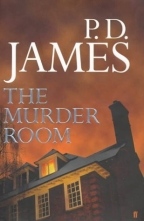The Murder Room
P. D. James
Faber
UK Hardcover First Edition
ISBN 0-571-21821-0
Publication Date: September, 2003
371 Pages; £17.99
Date Reviewed: 10-01-05
Reviewed by: Katie Dean © 2005

REFERENCES
COLUMNS
|
|
|
The Murder RoomP. D. JamesFaberUK Hardcover First EditionISBN 0-571-21821-0Publication Date: September, 2003371 Pages; £17.99Date Reviewed: 10-01-05Reviewed by: Katie Dean © 2005 |
s

|
|
REFERENCES |
COLUMNS |
'The Murder Room' follows the classic 'whodunnit' plot. It offers multiple bodies, a cast of suitably dubious characters and, for P. D. James fans, the familiar Commander Dalgleish and team. It is also a novel rich in descriptive detail, but for all this, it remains vaguely unsatisfying. Insufficiently distinct from other novels of this genre, 'The Murder Room' is an easy-going, but unprepossessing read.
Existing fans of P. D. James' detective fiction will almost certainly relish the opportunity to follow another case undertaken by Commander Adam Dalgleish. An eminently likeable detective, distinguished by his passion for poetry, he is sensitive, obsessive and suffers a very messy private life that contrasts starkly with the success he has found in his work. For anyone who has read previous cases, Dalgleish's private life affords James the opportunity to continue the story that runs as a linking thread throughout her crime novels. Other of Dalgleish's colleagues will also appear familiar and subtle references to previous cases provide a satisfying sense of being on familiar territory. However, this is not to put off those who are new to James. She has succeeded, where many authors fail, in striking the right balance between providing sufficient information to be meaningful and avoiding the trap of tediously reiterating large chunks of previous plots. For those who have read previous cases, this information is a helpful and gentle reminder of what has gone before. For those who are new to the investigating team, it provides a personal context that affords humanity to these key characters.
Of course, the real interest lies in the present case. Tantalisingly entitled, 'The Murder Room', one conjures up images of multiple and probably gruesome murders, a suitable satisfaction for the macabre in all of us. In fact the novel is not as fast paced as its title might suggest. James excels at minute descriptions of people and places and goes to a lot of trouble to provide a significant cast of potential killers. From the outset it becomes clear that one character is the clearly intended victim, surrounded by a host of ill-wishers. However, the inevitable murder does not take place until almost a third of the way through the novel. The ensuing investigation is equally reliant upon long descriptive passages of interviews and introduces a further sub-cast of witnesses and informants. Such a large and unwieldy cast is inherently risky for any author and, sadly, James falls foul of the sheer numbers she has introduced. The novel is lacking in good character development and this, in turn impacts upon its power as a mystery book or detective thriller. From the time before the murder has taken place, it is clear that a number of characters have good motives. Once the investigation begins, the strength of each motive remains broadly the same. The new information that comes to light in each chapter fails to either implicate or exonerate any suspect. The effect is to create a long list of evidence presented in a manner that affords no 'light and shade', no excitement or increase in the intensity of the investigation. It is not until the last few chapters that the pace begins to increase and eventually reach a satisfying climax. In concept, this very much follows the formula of an Agatha Christie novel. However, Christie's cases retain their excitement by focusing on a smaller group of people and gradually revealing pointed clues that both reveal her gift for painting humanity and lead the reader to a definite conclusion regarding the suspect, albeit usually the wrong conclusion! James' characters drift in and out of the story, leaving a slight sense of confusion and a dissatisfying feeling that none of them have become well-known, appealing or unlikeable.
'The Murder Room' is a classic detective novel following the traditional pattern. It offers multiple murders and a familiar detective. However, it lacks excitement and the mystery is not sufficiently planned to allow the reader to become a true part of the investigation. For all that, it is an enjoyable book and a good vehicle for James' talents as a descriptive prose writer.